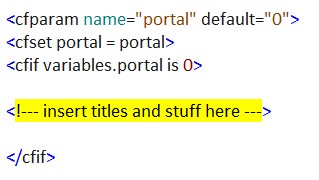For me, the problem is I use Coldfusion, so my forum is on a Linux php server (.info) while all my dynamic software is over on an NT cfml server (.com). I would really like to have more integration between these two, but it requires more coding-learning-curve than I have time for to get the forum and/or dojo's registration "integrated" in the two websites with different languages. I already spend hours I should be sleeping, working free for the cfml site. If anybody should know of something existing like this, I would trade money, sex or volunteer work for it. Maybe.
So I finally got the SMF+SP+CP combination set up, and the dilemma is:
How can I get my various cool-stuff 'display-only' from my coldfusion comserver, where all the action happens in my projects, to function or display "inside" my developing website in php on the infoserver?
Better yet, could it be possible to make it so people could browse my normally login-only coldfusion website from INSIDE the portal on the other server? Because I can control the permissions on that side, after all. They might get a nice "you need to register over here too" message if they want to add something but that would still make it way easier than having two completely separate worlds, which is the case right now.
These three php apps/mods (SMF+SP+CP) actually make this possible! Wow, the possibilities seem endless now!
For my first super-simple experiment, I made the index.cfm page on my coldfusion comserver work in both places. It sets a parameter called portal to default to 0 and uses IF. If someone arrives at the home domain there, they see some titles at the top, and a link to the forum at top right. Also the 'home' links are a bit different.

If they arrive at the portal home which is my PhP driven infoserver, they see that same included page but without the titles, icon, and different 'home' links, because the forum/portal already has a big title/nav. In my Simple Portal I created a block called 'welcome' which is Custom HTML, ignore permissions, show block on portal:

So what this proves to me is that I can make pages in coldfusion on one server, set them for certain parameters that will pull them directly into the framework in php on another server, and then control the access of those pages in the portal via permissions over there, so even if I normally would not want something to display outside the login, in this case if they're logged in over-there-instead that'll still work.
I think this will go a long way toward integration as well as to making more groovy stuff available to people who frequent the forum.
PJ
![Validated RSS feed [Valid RSS]](http://www.dojopsi.com/tkr/valid-rss.png)